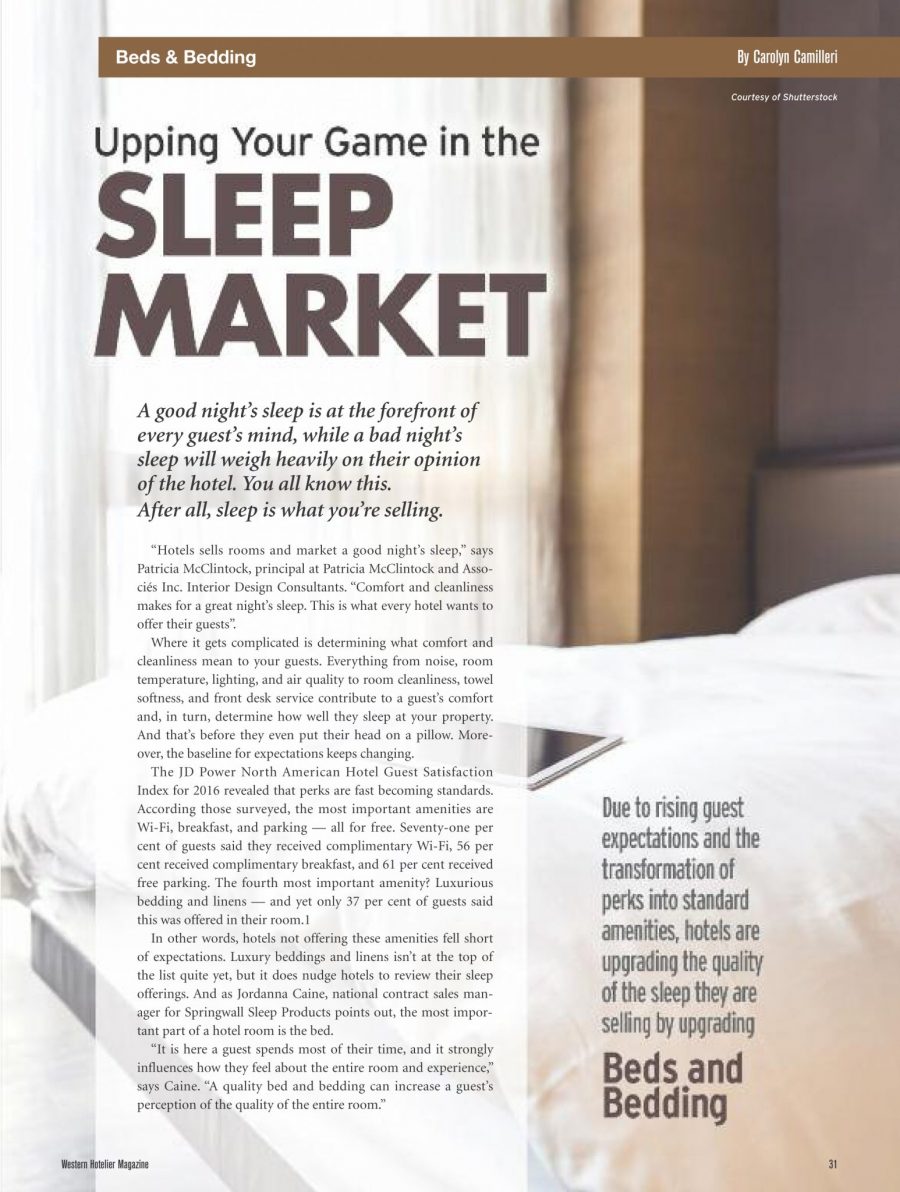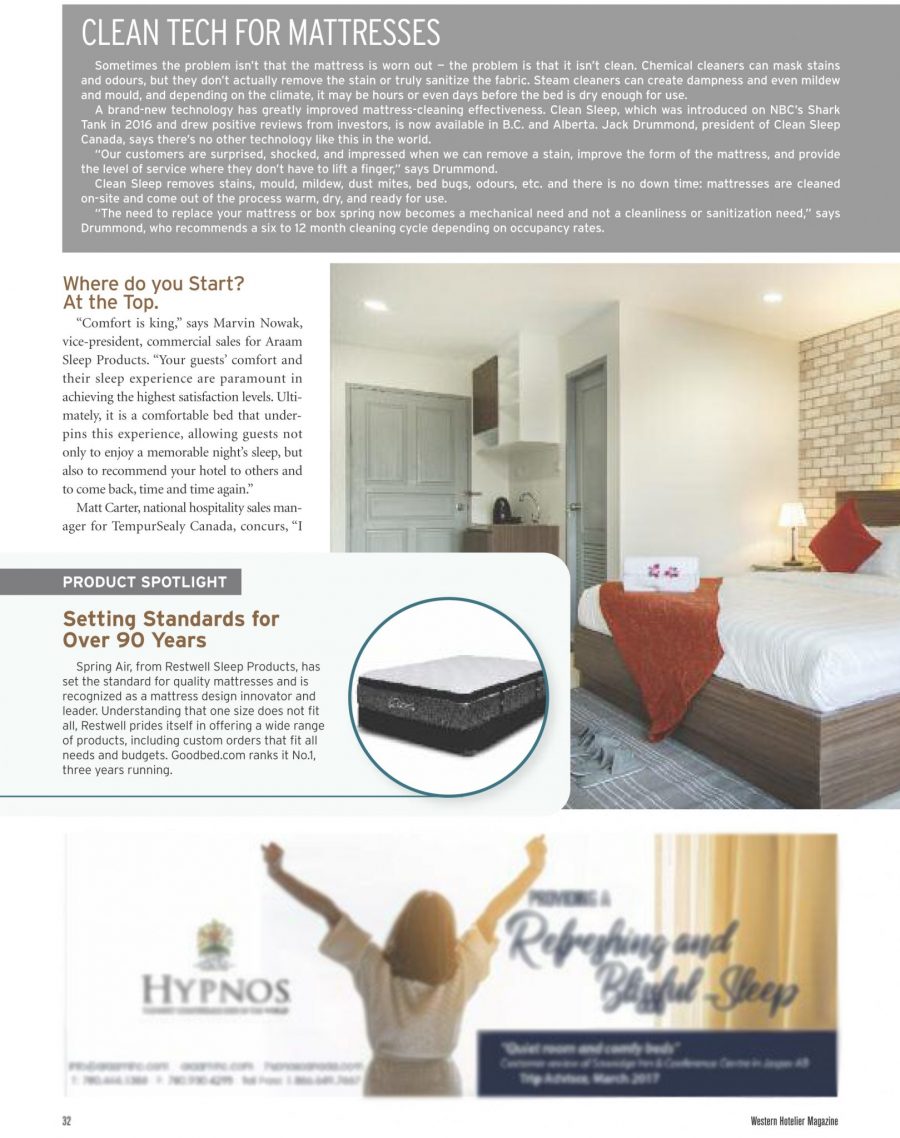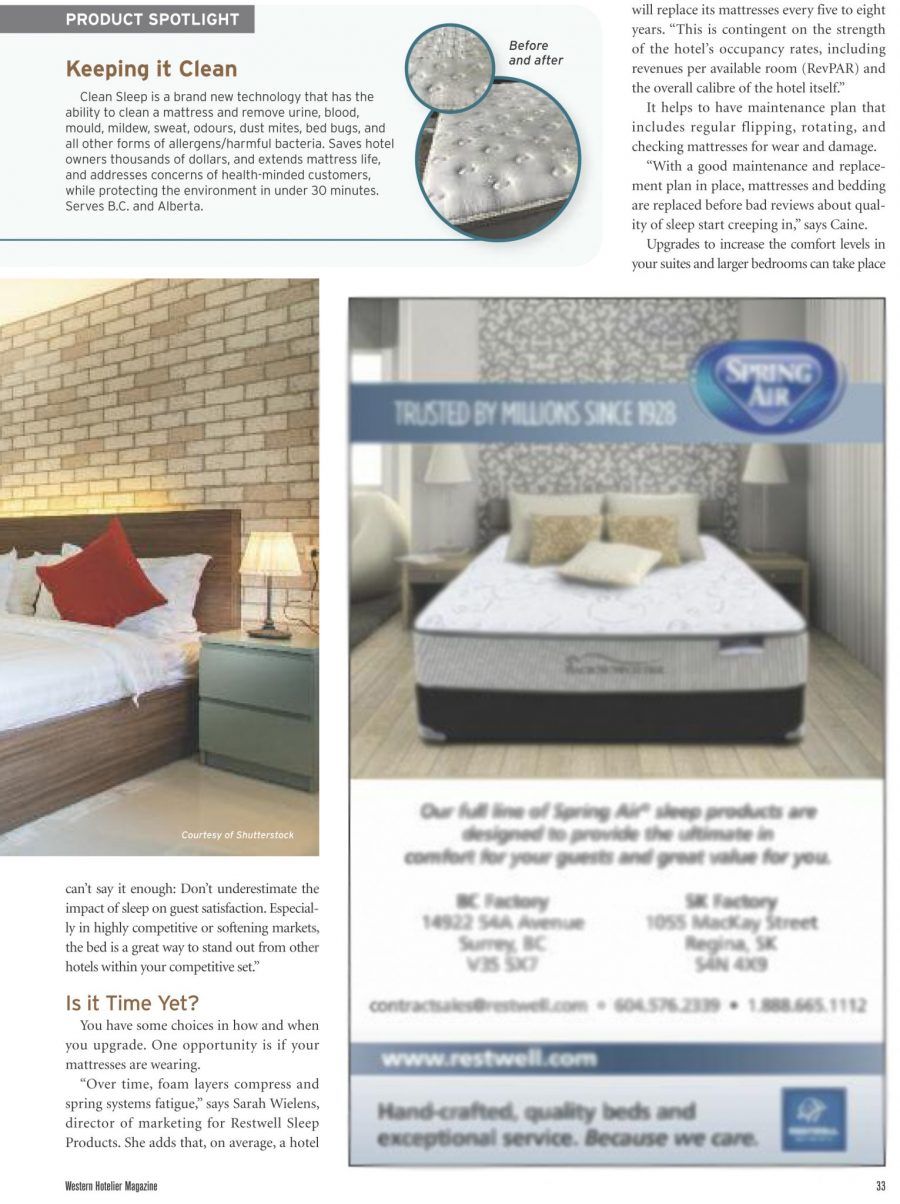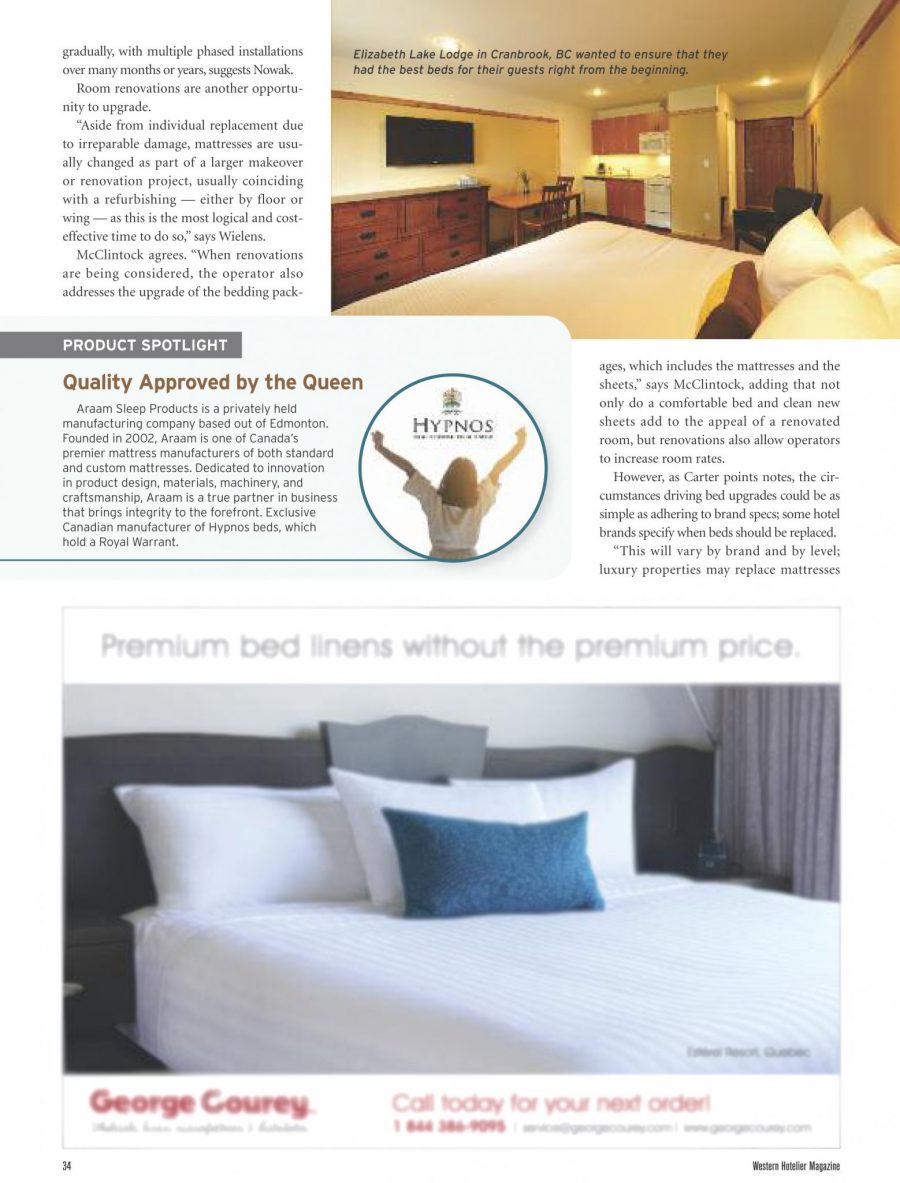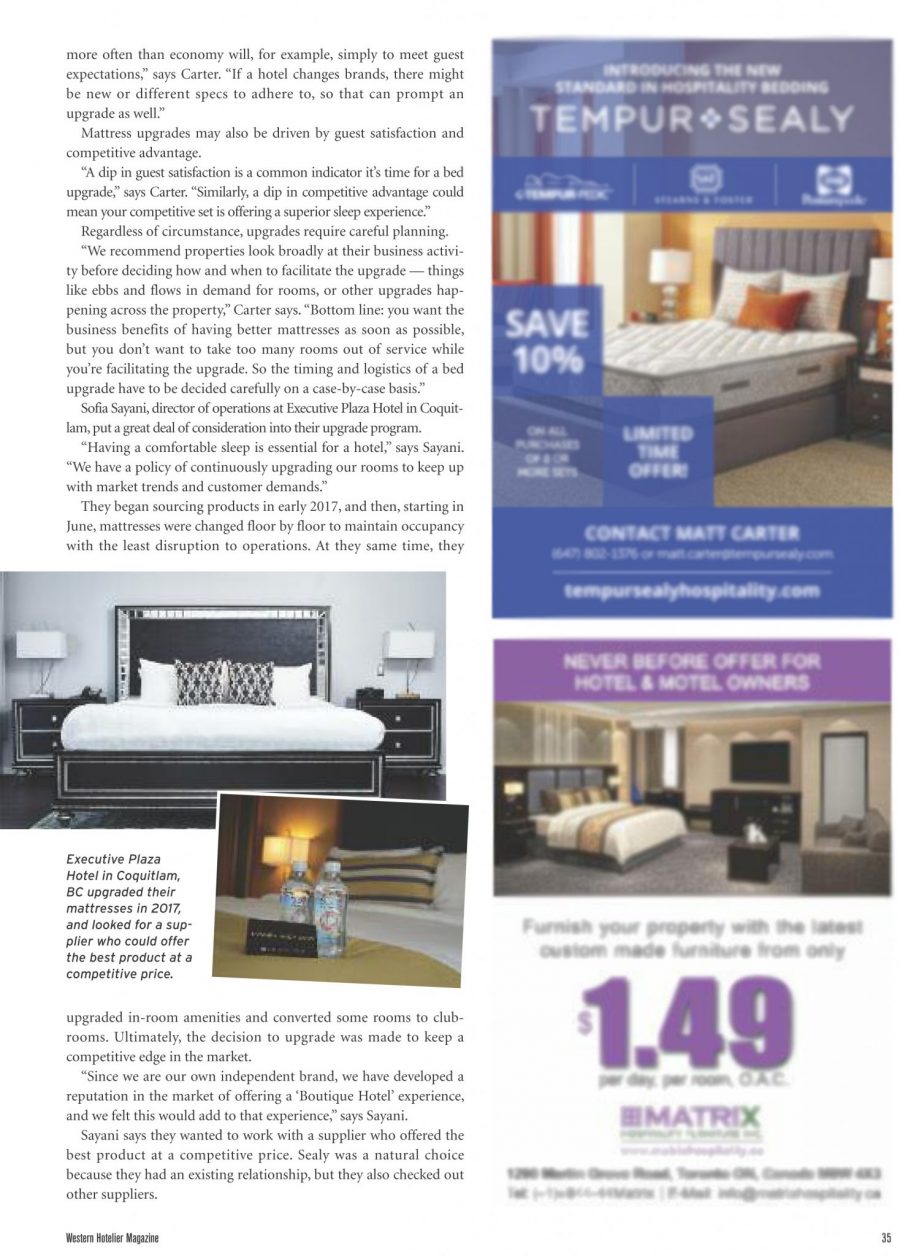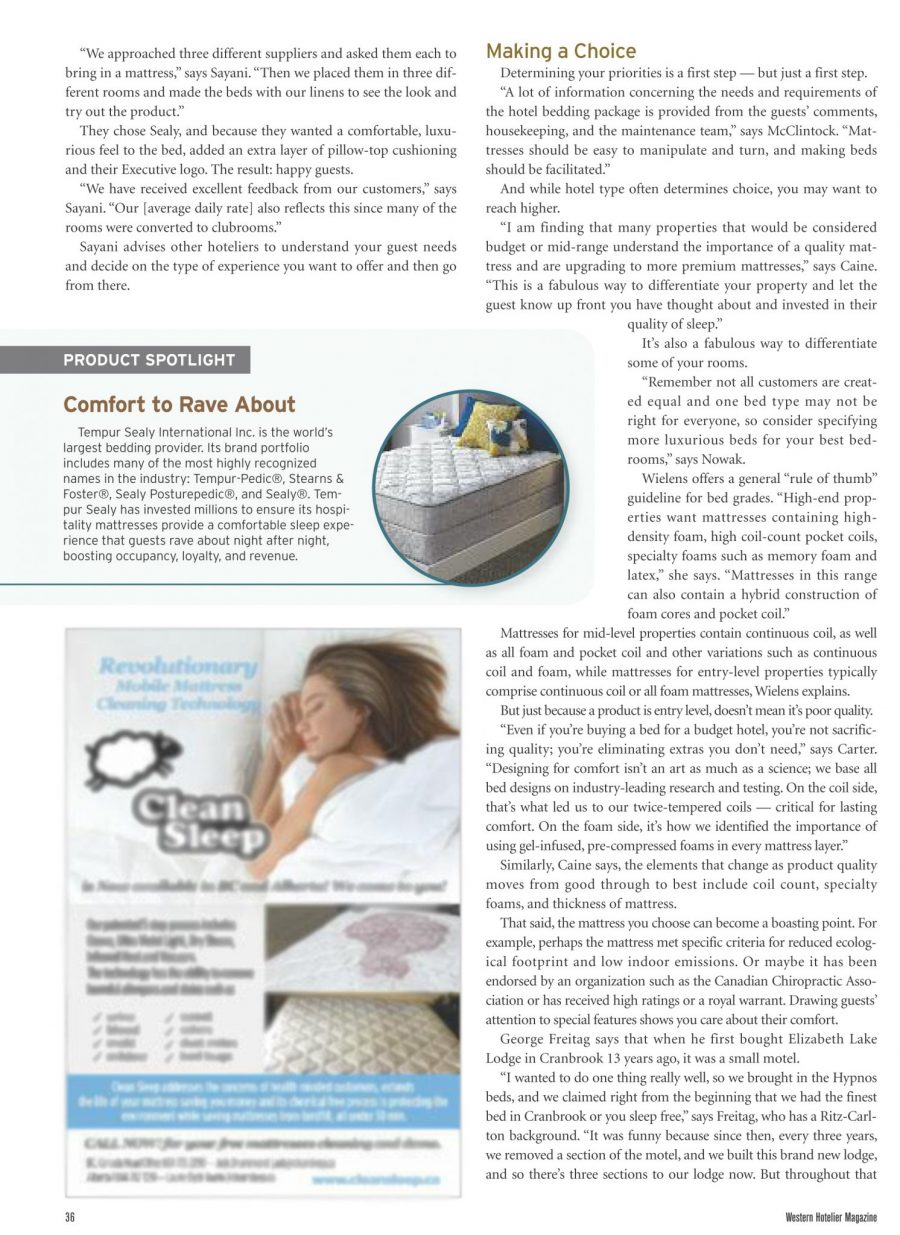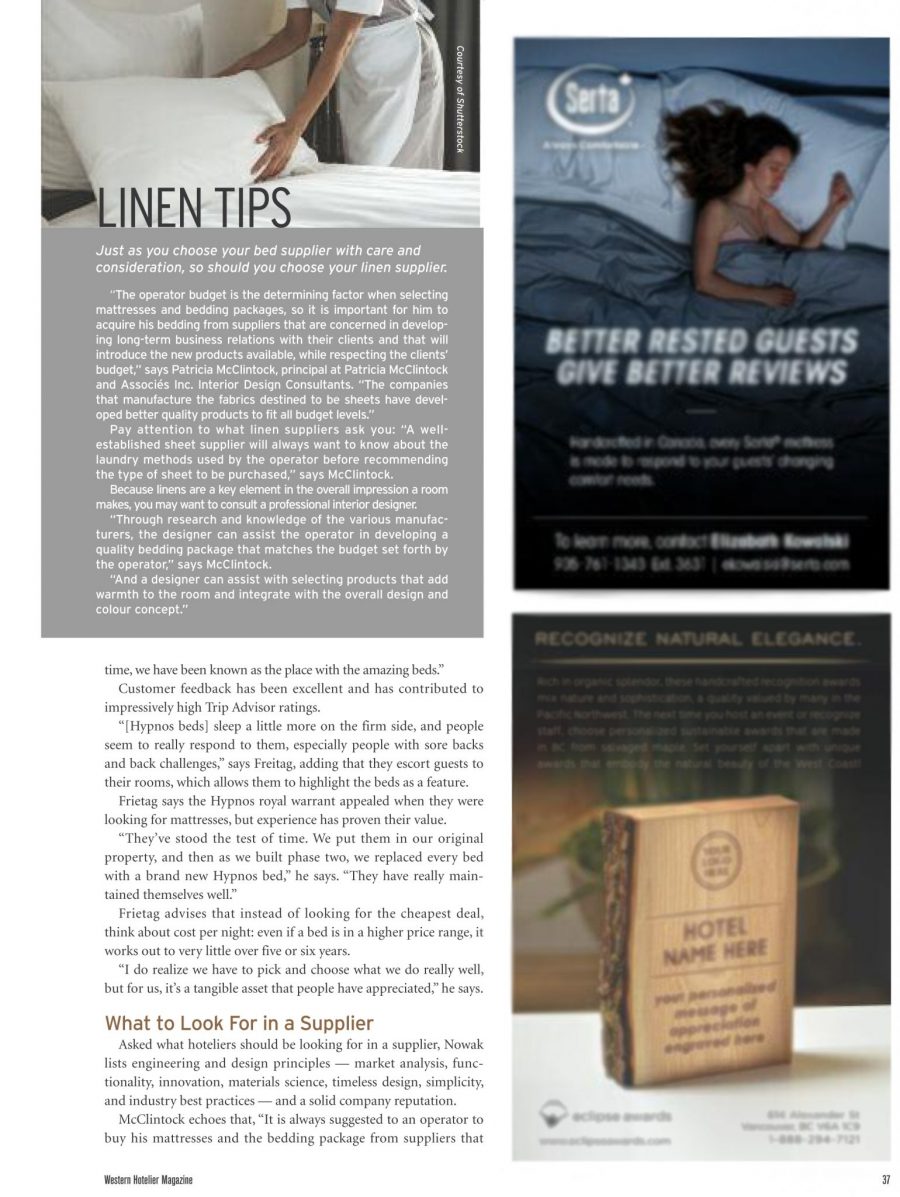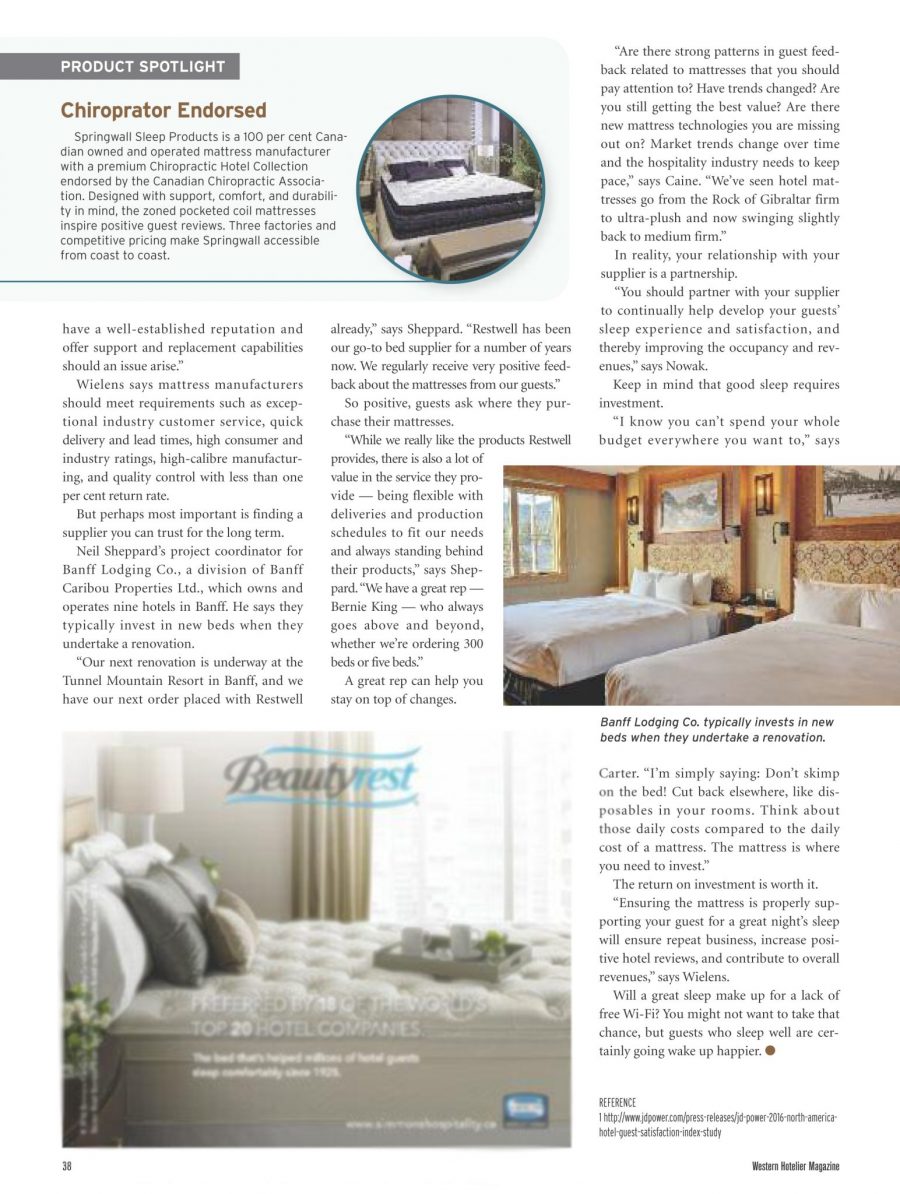
Beds & Bedding – By Carolyn Camilleri
Upping Your Game in the
Sleep Market
A good night’s sleep is at the forefront of every guest’s mind, while a bad night’s sleep will weigh heavily on their opinion of the hotel. You all know this. After all, sleep is what you’re selling.
“Hotels sells rooms and market a good night’s sleep,” says Patricia McClintock, principal at Patricia McClintock and Associés Inc. Interior Design Consultants. “Comfort and cleanliness
makes for a great night’s sleep. This is what every hotel wants to offer their guests.”
Where it gets complicated is determining what comfort and cleanliness mean to your guests. Everything from noise, room temperature, lighting, and air quality to room cleanliness, towel softness, and front desk service contribute to a guest’s comfort and, in turn, determine how well they sleep at your property. And that’s before they even put their head on a pillow. Moreover, the baseline for expectations keeps changing.
The JD Power North American Hotel Guest Satisfaction Index for 2016 revealed that perks are fast becoming standards. According those surveyed, the most important amenities are Wi-Fi, breakfast, and parking — all for free. Seventy-one per cent of guests said they received complimentary Wi-Fi, 56 per cent received complimentary breakfast, and 61 per cent received free parking. The fourth most important amenity? Luxurious bedding and linens — and yet only 37 per cent of guests said this was offered in their room.
In other words, hotels not offering these amenities fell short of expectations. Luxury beddings and linens isn’t at the top of the list quite yet, but it does nudge hotels to review their sleep offerings. And as Jordanna Caine, national contract sales manager for Springwall Sleep Products points out, the most important part of a hotel room is the bed.
“It is here a guest spends most of their time, and it strongly influences how they feel about the entire room and experience,” says Caine. “A quality bed and bedding can increase a guest’s perception of the quality of the entire room.”
Where do you Start? At theTop.
“Comfort is king,” says Marvin Nowak, vice-president, commercial sales for Araam Sleep Products. “Your guests’ comfort and their sleep experience are paramount in achieving the highest satisfaction levels. Ultimately, it is a comfortable bed that underpins this experience, allowing guests not only to enjoy a memorable night’s sleep, but also to recommend
your hotel to others and to come back, time and time again.”
Matt Carter, national hospitality sales manager for TempurSealy Canada, concurs, “I can’t say it enough: Don’t underestimate the impact of sleep on guest satisfaction. Especially in highly competitive or softening markets, the bed is a great way to stand out from other hotels within your competitive set.”
Is it Time Yet?
You have some choices in how and when you upgrade. One opportunity is if your mattresses are wearing.
“Over time, foam layers compress and spring systems fatigue,” says Sarah Wielens, director of marketing for Restwell Sleep Products. She adds that, on average, a hotel will replace its mattresses every five to eight years. “This is contingent on the strength of the hotel’s occupancy rates, including revenues per available room (RevPAR) and the overall caliber of the hotel itself.”
It helps to have a maintenance plan that includes regular flipping, rotating, and checking mattresses for wear and damage.
“With a good maintenance and replacement plan in place, mattresses and bedding are replaced before bad reviews about quality of sleep start creeping in,” says Caine.
Upgrades to increase the comfort levels in your suites and larger bedrooms can take place gradually, with multiple phased installations over many months or years, suggests Nowak.
Room renovations are another opportunity to upgrade.
“Aside from individual replacement due to irreparable damage, mattresses are usually changed as part of a larger makeover or renovation project, usually coinciding with a refurbishing — either by floor or wing — as this is the most logical and cost effective time to do so,” says Wielens.
McClintock agrees. “When renovations are being considered, the operator also addresses the upgrade of the bedding packages, which includes the mattresses and the sheets,” says McClintock, adding that not only do a comfortable bed and clean new sheets add to the appeal of a renovated room, but renovations also allow operators to increase room rates.
However, as Carter points notes, the cir……
LINEN TIPS
Just as you choose your bed supplier with care and consideration, so should you choose your linen supplier.
“The operator budget is the determining factor when selecting mattresses and bedding packages, so it is important for him to acquire his bedding from suppliers that are concerned in developing long-term business relations with their clients and that will introduce the new products available, while respecting the clients’ budget,” says Patricia McClintock, principal at Patricia McClintock and Associés Inc. Interior Design Consultants. “The companies that manufacture the fabrics destined to be sheets have developed better quality products to fit all budget levels.”
Pay attention to what linen suppliers ask you: “A well-established sheet supplier will always want to know about the laundry methods used by the operator before recommending the type of sheet to be purchased,” says McClintock.
Because linens are a key element in the overall impression a room makes, you may want to consult a professional interior designer.
“Through research and knowledge of the various manufacturers, the designer can assist the operator in developing a quality bedding package that matches the budget set forth by the operator,” says McClintock.
And a designer can assist with selecting products that add warmth to the room and integrate with the overall design and colour concept.”
cumstances driving bed upgrades could be as simple as adhering to brand specs; some hotel brands specify when beds should be replaced.
“This will vary by brand and by level; luxury properties may replace mattresses more often than economy will, for example, simply to meet guest expectations,” says Carter. “If a hotel changes brands, there might be new or different specs to adhere to, so that can prompt an upgrade as well.”
Mattress upgrades may also be driven by guest satisfaction and competitive advantage.
“A dip in guest satisfaction is a common indicator it’s time for a bed upgrade,” says Carter. “Similarly, a dip in competitive advantage could mean your competitive set is offering a superior sleep experience.”
Regardless of circumstance, upgrades require careful planning.
“We recommend properties look broadly at their business activity before deciding how and when to facilitate the upgrade — things like ebbs and flows in demand for rooms, or other upgrades happening across the property,” Carter says. “Bottom line: you want the business benefits of having better mattresses as soon as possible, but you don’t want to take too many rooms out of service while you’re facilitating the upgrade. So the timing and logistics of a bed upgrade have to be decided carefully on a case-by-case basis.”
Making a Choice
Determining your priorities is a first step — but just a first step.
“A lot of information concerning the needs and requirements of the hotel bedding package is provided from the guests’ comments, housekeeping, and the maintenance team,” says McClintock. “ Mat-tresses should be easy to manipulate and turn and making beds should be facilitated.”
And while hotel type often determines choice, you may want to reach higher.
“I am finding that many properties that would be considered budget or mid-range understand the importance of a quality mattress and are upgrading to more premium mattresses,” says Caine. “This is a fabulous way to differentiate your property and let the guest know up front you have thought about and invested in their quality of sleep.”
It’s also a fabulous way to differentiate some of your rooms.
“Remember not all customers are created equal and one bed type may not be right for everyone, so consider specifying more luxurious beds for your best bedrooms,” says Nowak.
Wielens offers a general “rule of thumb” guideline for bed grades. “High-end properties want mattresses containing high-density foam, high coil-count pocket coils, specialty foams such as memory foam and latex,” she says. “Mattresses in this range can also contain a hybrid construction of foam cores and pocket coil.”
Mattresses for mid-level properties contain continuous coil, as well as all foam and pocket coil and other variations such as continuous coil and foam, while mattresses for entry-level properties typically comprise continuous coil or all foam mattresses, Wielens explains.
But just because a product is entry level, doesn’t mean its poor quality.
“Even if you’re buying a bed for a budget hotel, you’re not sacrificing quality; you’re eliminating extras you don’t need,” says Carter. “Designing for comfort isn’t an art as much as a science; we base all bed designs on industry-leading research and testing. On the coil side, that’s what led us to our twice-tempered coils — critical for lasting comfort. On the foam side, it’s how we identified the importance of using gel-infused, pre-compressed foams in every mattress layer.”
Similarly, Caine says, the elements that change as product quality moves from good through to best include coil count, specialty foams, and thickness of mattress.
That said, the mattress you choose can become a boasting point.
For example, perhaps the mattress met specific criteria for reduced ecological footprint and low indoor emissions. Or maybe it has been endorsed by an organization such as the Canadian Chiropractic Association or has received high ratings or a royal warrant. Drawing guests’ attention to special features shows you care about their comfort.
What to Look for in a Supplier
Asked what hoteliers should be looking for in a supplier, Nowak lists engineering and design principles — market analysis, functionality, innovation, materials science, timeless design, simplicity, and industry best practices — and a solid company reputation.
McClintock echoes that, “It is always suggested to an operator to buy his mattresses and the bedding package from suppliers that have a well-established reputation and offer support and replacement capabilities should an issue arise.”
Wielens says mattress manufacturers should meet requirements such as exceptional industry customer service, quick delivery and lead times, high consumer and industry ratings, high-caliber manufacturing, and quality control with less than one per cent return rate.
But perhaps most important is finding a supplier you can trust for the long term, with a great sales rep who can help you stay on top of changes.
“Are there strong patterns in guest feedback related to mattresses that you should pay attention to? Have trends changed? Are you still getting the best value? Are there new mattress technologies you are missing out on? Market trends change over time and the hospitality industry needs to keep pace,” says Caine. “We’ve seen hotel mattresses go from the Rock of Gibraltar firm to ultra-plush and now swinging slightly back to medium firm.”
In reality, your relationship with your supplier is a partnership.
“You should partner with your supplier to continually help develop your guests’ sleep experience and satisfaction, and thereby improving the occupancy and revenues,” says Nowak.
Eastern Hotelier Magazine


